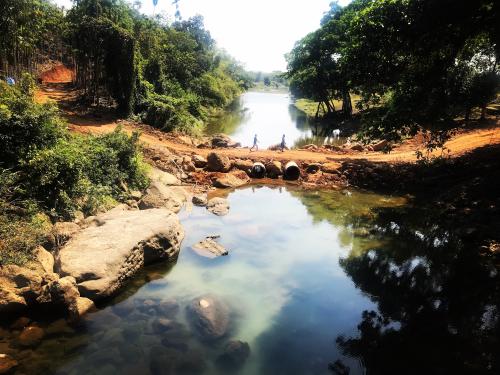Content from the Brookings Institution India Center is now archived. After seven years of an impactful partnership, as of September 11, 2020, Brookings India is now the Centre for Social and Economic Progress, an independent public policy institution based in India.
Sambandh Scholars Speak is a series of blog posts that feature evidence-based research on South Asia with a focus on regional studies and cross-border connectivity. The series engages with authors of recent books, articles, and reports on India and its neighbouring countries.
In this edition of our blog series on issues related to India’s neighborhood connectivity, Nidhi Varma interviews Avinash Paliwal, on his recent work “A Cat’s Paw of Indian Reactionaries”? Strategic Rivalry and Domestic Politics at the India–China–Myanmar Tri-Junction published in Asian Security, 2020.
Avinash is the Deputy Director of the South Asia Institute and Lecturer in Diplomacy and Public Policy at SOAS University of London. He specialises in South Asian strategic affairs and is currently working on a post-independence strategic history of India’s immediate east.
He is the author of My Enemy’s Enemy: India in Afghanistan from the Soviet Invasion to the US Withdrawal (New York: Oxford University Press, 2017).
Q. In your recently published article, [1] you argue that geopolitical factors of inter-state competition between India and China do not adequately explain India’s approach to its boundary with Myanmar. Domestic factors (Mizo insurgency and Naga separatism) may have been more important in determining India’s foreign policy stance. Can you briefly tell us how domestic factors better explain India’s approach to the Boundary Agreement of 1967?
A. The significance of, and fluctuations in, India’s relations with China often impart a sense that New Delhi’s foreign-policy vis-à-vis neighbour such as Myanmar is influenced mostly by its rivalry with Beijing. Though true to some extent, the unpacking of cases such as the signing of the India-Burma Boundary Agreement in 1967 complicates this picture. Arguably, given India’s territorial disputes with China, formalising the Burma boundary should have been high priority. Still, it took India two decades after independence, and five years after a border war with China, to broach the subject with Rangoon.
The reasons for such timing are grounded in India’s domestic politics and national security imperatives. More than India’s rivalry with China, it was the outbreak of the Mizo insurgency in 1966, coupled with an ongoing Naga insurgency, which pressed India into action to resolve its boundary dispute with Burma. The insurgencies were potent enough to make India, bigger of the two countries, to willfully cede territory to Burma if required. Such a move was inconceivable at a time when the defeat of 1962 was fresh and losing territory could result in severe political damage for a government in New Delhi.
Given India’s territorial disputes with China, formalising the Burma boundary should have been high priority. Still, it took India two decades after independence, and five years after a border war with China, to broach the subject with Rangoon.
Yet, a combination of worsening security situation and a requirement for India to assert its administrative presence (Burmese military routinely crossed the porous border into India) and demonstrate its distribution potential in its northeastern frontier regions, pushed India to formalise the boundary. In fact, such was Delhi’s urgency to sign the agreement that it ended up losing territory near Moreh in Manipur not out of will, but due to last-minute technical errors by its map-makers.
Simultaneous worsening of Sino-Burmese relations during this period –due to Mao’s interventionist Cultural Revolution and the ensuing anti-Chinese riots across Burma– enabled General Ne Win to positively reciprocate to India’s boundary formalisation requests. But it also meant that Burma, which had settled its own boundary dispute with China in 1961, let go of its territorial demands at the China-India-Burma tri-junction in Arunachal Pradesh, making an erstwhile three-party territorial dispute into a decisively India-China issue.
Q. Your related work [2] analyses New Delhi’s refusal to consult with state governments when negotiating its border in the east. How much of this approach is inherited from its colonial past? And did it ultimately backfire on New Delhi?
A. I found India’s decision to not consult state governments before reaching out to Rangoon to formalise the boundary somewhat counter-intuitive. After all, if it was domestic political and security drivers that informed the timing of Delhi’s outreach, then why alienate stakeholders whose welfare India sought to advance in the first place, and whose lives were to be affected by the boundary agreement? At the heart of this question is the element of continuity between India and Burma’s colonial past to its then postcolonial present. Both countries’ inheritance and unquestioning acceptance of a boundary drawn by colonial authorities for administrative convenience meant that they also accepted the associated costs.
In practice, this meant that Delhi would not alter the boundary as demanded by stakeholders in the Northeast. In Manipur, for instance, various groups sought the accession of the Kabaw Valley to India. This issue had raged since 1834 when the valley was ceded to Burma in its entirety to placate anti-imperial protests–only creating anti-imperial sentiment in Manipur, as it bereaved the kingdom access to large tracts of teak-forests. Most communities straddling across the boundary viewed it as an unfair colonial imposition that either divided ethnic kin or deprived them of their rightful resources. These grievances, which became rooted in local cultures, carried through in the post-independence period.
Prime Minister Indira Gandhi’s decision to not consult state governments was meant to avoid the derailment of the boundary formalisation due to expected local opposition. In doing so, India continued with the colonial tradition of bypassing local demands for national (previously imperial) needs, but did so in a postcolonial manner i.e. by invoking the Constitution of India that allocated foreign policy to the Union List. As late as 1974, when Survey of India officials recommended state-level involvement in the demarcation process, the Ministry of External Affairs shot down the idea arguing: “it is not necessary to obtain approval or enter into detailed discussion with State Governments on frontier question which are central responsibility.”
In the immediate term, such lack of consultation did not backfire as India succeeded in signing the agreement and demarcating the boundary. But, the ensuing protests across Manipur, Nagaland, Assam, and later Mizoram, ensured that India could never translate the agreement into a boundary treaty as envisioned. The agreement also fed into grievances about India’s ‘colonial’ approach towards the Northeast and became a strong narrative plank within various insurgent movements. Unfortunately, despite the Northeast’s steady (if not even) political and economic integration with India over the decades’ resentment over the boundary persists till today.
Q. You are currently working on a book project which focuses on India’s larger foreign policymaking processes towards Myanmar since Independence. You have previously worked extensively on India and Afghanistan. Why is it increasingly relevant to study India’s neighborhood and the South Asian region?
A. Of the many reasons to study India’s neighborhood and the South Asian region –lack of systematic scholarship and the region’s rich sociological landscape– the most important reason for me is to unpack the contradictions of contemporary India. To better understand, for instance, how a country that has long advocated external non-interference in sovereign affairs, navigates interventionism in a region where it enjoys dominance. Or, more recently, to revisit long-standing assumptions such as India’s preference for a unipolar South Asia, in the light of its willing engagement with external powers such as the US and Japan to counter increasing Chinese influence in the region.
My research on India’s role in Afghanistan made me realize how important it is to delve into case specifics to truly understand the gravity of South Asian geopolitics on global affairs.
Far from being at the periphery of the global system, as viewed during the Cold War wherein Europe was considered pivotal, South Asia is currently at the center of unfolding global processes. Be it great power competition with the rise of China, connectivity projects, nuclear politics, religious extremism and nationalism, experience of and debates around climate change, creation of economic production hubs, or the use and abuse of new technologies, India and its neighborhood is witnessing extremes across this spectrum. Extremes that will not just shape the present and future of nearly 1.9-billion people in the subcontinent, but of the world altogether. To make sense of how these issues may pan out in the future, dedicated study of India and its region –I would include the entire Indian Ocean Region in this, not because it’s “India’s Ocean”, but because it cannot be imagined and understood without India– is imperative and urgent.
My research on India’s role in Afghanistan made me realise how important it is to delve into case specifics to truly understand the gravity of South Asian geopolitics on global affairs. For instance, India has played an active, if not central, role in shaping the contours of war and peace in Afghanistan–and will continue to doing so in the future. Similarly, research on India’s approach towards Myanmar has sensitised me to the explanatory limits of high-geopolitics and meta-narratives such as Sino-Indian competition and the Act East Policy (AEP) respectively. The AEP, often viewed in conjunction with the new construct of the Indo-Pacific, is just as good as the evolving ground-realities in Northeast India, Myanmar, and Bangladesh will permit it to be; and how New Delhi and other interested world capitals will deal with these realities.
 About the expert: Avinash Paliwal is Deputy Director of the South Asia Institute and Lecturer in Diplomacy and Public Policy at SOAS University of London. He specialises in South Asian strategic affairs and is currently working on a post-independence strategic history of India’s immediate east. He is the author of My Enemy’s Enemy: India in Afghanistan from the Soviet Invasion to the US Withdrawal (New York: Oxford University Press, 2017)
About the expert: Avinash Paliwal is Deputy Director of the South Asia Institute and Lecturer in Diplomacy and Public Policy at SOAS University of London. He specialises in South Asian strategic affairs and is currently working on a post-independence strategic history of India’s immediate east. He is the author of My Enemy’s Enemy: India in Afghanistan from the Soviet Invasion to the US Withdrawal (New York: Oxford University Press, 2017)
He can be contacted at [email protected]
[1] Avinash Paliwal (2020) “A Cat’s Paw of Indian Reactionaries”? Strategic Rivalry and Domestic Politics at the India–China–Myanmar Tri-Junction, Asian Security, 16:1, 73-89, DOI: 10.1080/14799855.2018.1551884
[2] Avinash Paliwal (2019) “How many miles make an inch?” Centre-state relations and the 1967 India-Burma Boundary Agreement, India Review, 18:5, 596-612, DOI: 10.1080/14736489.2019.1703368





Commentary
India and Myanmar: The role of domestic calculations in the boundary agreement of 1967
April 13, 2020